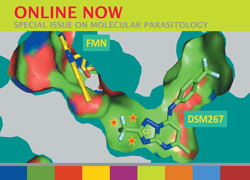issue contents
July 2018 issue

Cover illustration: Crystal structure of N-acetylmannosamine-6-phosphate 2-epimerase from Vibrio cholerae (Manjunath et al., p. 431). Studies on NanE from V. cholerae and Fusobacterium nucleatum have allowed an evaluation of whether NanE may be a good drug target against these pathogenic bacteria.
research communications
Two different conformations, closed and open forms, of the E. coli poly-α-L-glutamate synthetase protein RimK were determined in complex with the ATP analogue AMP-PNP by X-ray crystallography at 2.05 Å resolution. The structure of the open form of RimK is unique and differs substantially from the structures of its homologues.
PDB reference: RimK, 5zct
The crystallization and structural analysis of the various players in the ataRT toxin–antitoxin module from enteropathogenic Escherichia coli are reported: the toxin AtaT, the intrinsically disordered antitoxin AtaR and its complex with a 22 bp fragment of the operator DNA.
The three-dimensional structure of Escherichia coli purine nucleoside phosphorylase (PNP) complexed with acyclovir has been solved and a comparison with other complexes of PNP with guanosine derivatives has been carried out.
A mobile application has been developed to facilitate the human annotation of crystallization images.
The gene encoding a novel bacterial class V dye-decolourizing peroxidase (DyP) from the extremely radiation-resistant and desiccation-resistant bacterium Deinococcus radiodurans was cloned and optimum conditions for high-yield expression were identified. The optimized crystals diffracted to 2.2 Å resolution and the initial characterization and crystallographic analysis is promising with respect to providing highly desired insights into this largely unknown family of DyPs.
The recombinant expression, purification, crystallization and crystal structure of human anterior gradient protein 3, a single-domain member of the protein disulfide isomerase family that lacks the canonical active-site motif, are described.
PDB reference: human anterior gradient protein 3, 3ph9
Structure–function studies on N-acetylmannosamine-6-phosphate 2-epimerases from F. nucleatum and V. cholerae reveal conserved features among this class of epimerases.


 journal menu
journal menu


















![[publBio]](/logos/publbio.gif)





